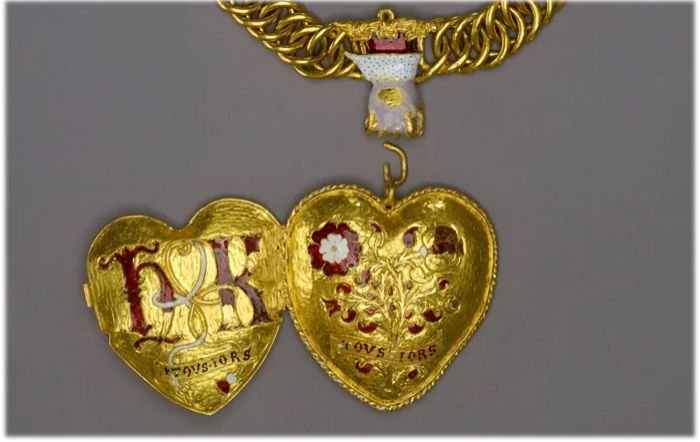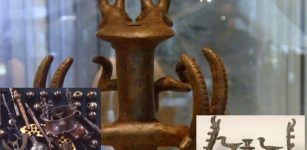Beautiful Tudor Gold Pendant Linked To Henry VIII And Katherine Of Aragon Discovered By A Metal-Detectorist
Jan Bartek - AncientPages.com - A beautiful gold pendant on a chain linked to King Henry VIII and Katherine of Aragon has been unveiled by the British Museum. Charlie Clarke, a metal detector, discovered the ornate item in Warwickshire, UK.
Under the Treasure Act 1996, any finders have a legal obligation to report all finds of potential treasure to local authorities.
Despite its eye-catching appearance, the gold pendant is believed to have been produced rapidly. Image credit: Birmingham Museums Trust, CC BY 2.0
Clarke "reported it to the local Finds Liaison Officer of the Portable Antiquities Scheme employed by Birmingham Museum Trust, who in turn contacted Historic England. We carried out an archaeological excavation at the site, to better understand the relationship between the find and its location. No other finds were discovered during this investigation," Historic England reports.
Image credit: Historic England
Henry VIII was King of England from 22 April 1509 until he died in 1547. Henry is best known for his six marriages and for his efforts to have his first marriage annulled. Katherine of Aragon was his first wife.
The 16th-century gold, "heart-shaped pendant is attached to a 75-link gold chain via an enamelled ‘hand’.
The front of the pendant is decorated with a red and white Tudor rose motif entwined with a pomegranate bush, the symbols of Henry and Katherine. These stem from the same branch, which at its base has a tail, and sits above the inscription + TOVS + IORS - a pun on the French for ‘always’.
The back shows the letters H and K - for Henry and Katherine - in Lombardic script, linked by ribbon, again with the legend + TOVS + IORS.
Analysis dates the pendant as early 16th century, from 1509 – 1533 AD with a most likely date of around 1521.
It appears that the pendant was produced rapidly; it may have been used as a prize or worn by people participating in an event. The design of the pendant is like that used on horse bards at a joust in Greenwich in 1521," Historic England reports.
"It is wonderful to see archaeology and metal-detecting across the country thriving – helping to uncover treasures which deepen our understanding of our shared national history. Supported by the success of the Treasure Act, it means that hundreds of wonderful discoveries are now in museums across the UK where they can be enjoyed by everyone," Lord Parkinson of Whitley Bay, Arts & Heritage Minister said.
The necklace also features an elaborate clasp with gloved hand design. Image credit: Birmingham Museums Trust, CC BY 2.0
"The 16th Century pendant was one of a number of objects outlined in the museum's Treasure Annual Report and Portable Antiques Scheme (PAS) Annual Report which highlights archaeological contributions from members of the public.
The museum also highlighted a silver strap-end, designed to finish a flat strip of fabric or leather, found in Hampshire by a metal detectorist.
The medieval object, which dates back to the 14th Century, is decorated with animals and was thought to belong to a merchant," BBC reports.
Written by Jan Bartek - AncientPages.com Staff Writer























